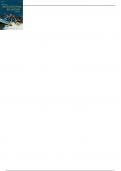,Chapter 1 An Introduction to Organizational Behaviour
MULTIPLE CHOICE
1. What three levels of study is organizational behaviour concerned with?
a. psychosocial, interpersonal, and organizational structure
b. psychosocial, interpersonal, and work design
c. interpersonal, group dynamics in organizations, and work design
d. individual, group and organizational
ANS: D PTS: 1 DIF: Easy REF: p. 6
OBJ: 1 BLM: Knowledge
2. The study of individual behaviour and group dynamics in organizational settings describes the content
of study in
a. organization theory.
b. organization design.
c. organizational behaviour.
d. organizational development.
ANS: C PTS: 1 DIF: Easy REF: p. 6
OBJ: 1 BLM: Knowledge
3. At which level of the organization do we study topics such as change, culture, and structure?
a. individual level
b. group or department level
c. organizational level
d. internal level
ANS: C PTS: 1 DIF: Moderate REF: p. 6
OBJ: 1 BLM: Knowledge
4. What field includes the study of human behaviour and individual differences?
a. anthropology
b. sociology
c. engineering
d. psychology
ANS: D PTS: 1 DIF: Moderate REF: p. 6
OBJ: 1 BLM: Knowledge
5. What studies demonstrated the impact of psychological processes and peer pressure on individual
behaviour and performance in a workplace?
a. scientific management
b. Hawthorne
c. human capital
d. chaos theory
ANS: B PTS: 1 DIF: Easy REF: p. 6
OBJ: 1 BLM: Knowledge
1Copyright © 2010 by Nelson Education Ltd.
,6. Bob knows how all programs on the company’s computers work, Elsie has incredible skill in working
with people while Chan has an unusual ability in analysis of information. What would best describe
these abilities from the perspective of management?
a. knowledge management
b. experience
c. skill diversity
d. human capital
ANS: D PTS: 1 DIF: Hard REF: p. 6
OBJ: 2 BLM: Comprehension
7. Culture and the study of learned behaviour comprise the domain of
a. management.
b. anthropology.
c. sociology.
d. psychology.
ANS: B PTS: 1 DIF: Easy REF: p. 7
OBJ: 1 BLM: Knowledge
8. Black & Decker placed a special emphasis on human productivity and efficiency through the
application of organizational goal setting and differential piece rate systems. This is an example of the
use of ideas from what field?
a. psychology
b. anthropology
c. sociology
d. engineering
ANS: D PTS: 1 DIF: Moderate REF: p. 7
OBJ: 1 BLM: Knowledge
9. Research focusing on the effects of efficient cultures on organizational performance and how
pathological personalities may lead to dysfunctional cultures highlights which discipline’s
contribution to organizational behaviour?
a. psychology
b. sociology
c. anthropology
d. medicine
ANS: C PTS: 1 DIF: Moderate REF: p. 7
OBJ: 1 BLM: Knowledge
10. Marsha wanted to know where the roots of theories of culture could be found. To which field of study
should she refer?
a. psychology
b. geography
c. anthropology
d. sociology
ANS: C PTS: 1 DIF: Moderate REF: p. 7
OBJ: 1 BLM: Knowledge
2 Copyright © 2010 by Nelson Education Ltd.
, 11. The first discipline to take the modern corporation as the unit of analysis and emphasize the design,
implementation, and coordination of various administrative and organization systems was
a. psychology.
b. sociology.
c. management.
d. anthropology.
ANS: C PTS: 1 DIF: Moderate REF: p. 7
OBJ: 1 BLM: Comprehension
12. Which of the following describe the nature of managerial work?
a. planning, organizing, leading, and controlling
b. communicating, leading, and planning
c. communicating, organizing, and leading
d. leading, planning, and motivating
ANS: A PTS: 1 DIF: Moderate REF: p. 8
OBJ: 2 BLM: Knowledge
13. Henry Mintzberg divided the functions of a manager into what four categories?
a. planning, organizing, leading, and controlling
b. interpersonal, informational, decisional, and organizational
c. interpersonal, planning, controlling,and organizing
d. leading, controlling, communicating, and human
ANS: A PTS: 1 DIF: Moderate REF: p. 8
OBJ: 2 BLM: Knowledge
14. Henry Mintzberg’s informational roles include which of the following?
a. monitor, disseminator, and spokesperson
b. spokesperson, liaison, and monitor
c. liaison, monitor, and decisional
d. decisional, disseminator, and monitor
ANS: A PTS: 1 DIF: Hard REF: p. 8
OBJ: 2 BLM: Knowledge
15. Henry Mintzberg’s decisional roles include which of the following?
a. entrepreneur, disseminator, and spokesperson
b. entrepreneur, resource allocator, and negotiator
c. liaison, monitor, and entrepreneur
d. resource allocator, disseminator, and monitor
ANS: B PTS: 1 DIF: Moderate REF: p. 8
OBJ: 2 BLM: Knowledge
3Copyright © 2010 by Nelson Education Ltd.




